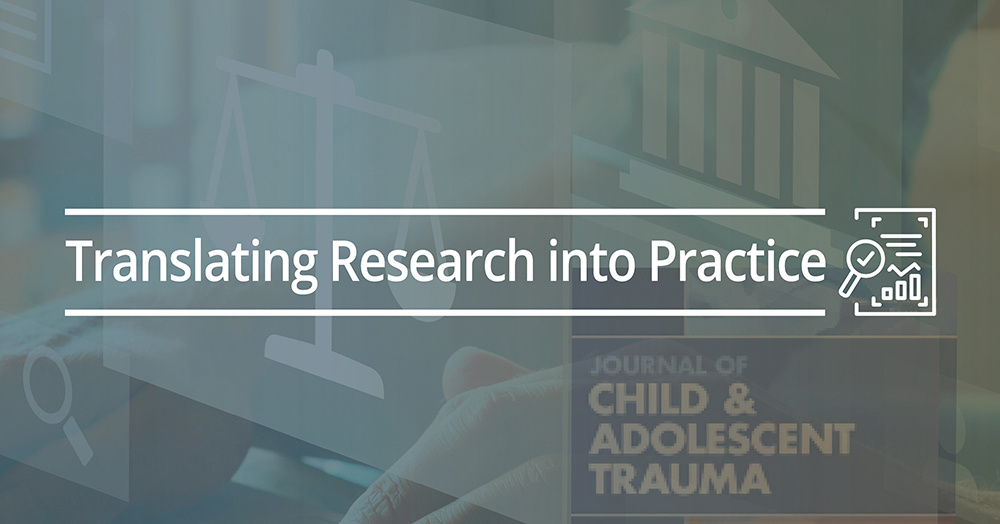Featured Article
Article Title
Quality of the Parent-Child Relationship as a Moderator of Witnessing Violence and Youth Trauma Symptoms
Authors
Lexie Unhjem; Department of Human Development and Family Science, Florida State University, Tallahassee, FL, USA
Lenore M. McWey; Department of Human Development and Family Science, Florida State University, Tallahassee, FL, USA
Thomas Ledermann; Department of Human Development and Family Science, Florida State University, Tallahassee, FL, USA
Tatjana M. Farley; Department of Human Development and Psychological Counseling, Appalachian State University, Boone, NC, USA
Abstract
Traumatic event exposure affects two in every three adolescents in the United States, and there is the potential for numerous deleterious effects including higher levels of youth depression, anxiety, posttraumatic stress symptoms, and emotional and behavioral problems. Witnessing violence is one of the more common experiences associated with trauma exposure. Despite the ample research on mental health outcomes associated with witnessing violence, less is known about the extent to which parent–child relationships play a role in youth mental health outcomes when youth are exposed to violence. With a clinically relevant, diverse sample of 806 youth ages 12 years old who experienced maltreatment or were at risk of being maltreated, we tested hypotheses that the parent–child relationship quality would moderate the associations between witnessing violence and youth mental health outcomes. Results supported hypotheses for youths’ symptoms of anxiety, depression, dissociation, and posttraumatic stress. The study contributes to the trauma literature by determining that the quality of the parent–child relationship moderated the effects of witnessing violence on trauma outcomes.
Keywords
Trauma; witnessing violence; parent–child relationship; youth; child; moderation
Summary of Research
This study investigates the impact of the parent-child relationship on the mental health outcomes of adolescents who witness violence. Understanding this dynamic is crucial as many children experience interpersonal trauma or adverse childhood experiences before adolescence, with a significant portion encountering multiple traumas leading to complex outcomes. The study aims to explore whether the quality of the parent-child relationship can buffer against negative mental health consequences such as anger, anxiety, depression, dissociation, and posttraumatic stress that often follow witnessing violence.
Previous research highlights that witnessing violence is among the most prevalent traumatic experiences for youth, with well-documented adverse effects including anxiety, depression, and behavioral issues. Studies have shown that problematic parent-child relationships can exacerbate these adverse outcomes, whereas positive family support and parenting practices can moderate the impact. However, there is a gap in the literature regarding how the quality of the parent-child relationship specifically affects mental health outcomes in adolescents from clinically relevant, child welfare-involved samples.
This longitudinal study, part of the Longitudinal Studies of Child Abuse and Neglect (LONGSCAN), tracked over 1,300 children identified as maltreated or at risk for maltreatment starting in 1991 and following them for 18 years. The study focuses on data collected when the participants were 12 years old (n=806). Measures used included a history of witnessed violence, parent-child relationship quality, and youth trauma symptoms, assessed through various standardized tools such as the Trauma Symptom Checklist for Children.
The study's findings underscore the significant role of the parent-child relationship in moderating the negative mental health outcomes associated with witnessing violence among youth. Specifically, the quality of the parent-child relationship buffered the impact of witnessing violence on anxiety, depression, dissociation, and post-traumatic stress, aligning with previous research. This highlights the importance of supportive parent-child interactions in mitigating these trauma-related symptoms. However, the parent-child relationship did not buffer the effects of witnessing violence on anger, suggesting that anger may be more directly influenced by the violent experiences themselves rather than the quality of familial relationships.
The study also revealed substantial gender differences in anxiety and depression, with females reporting higher levels of these symptoms than males. This may be due to differences in emotional socialization, where females are more likely to internalize emotions and cultural norms that discourage males from expressing sadness. These findings emphasize the complex interplay between gender, socialization, and mental health, suggesting that parent-child relationships and broader social influences both play crucial roles in shaping youth outcomes after witnessing violence.
Translating Research into Practice
Focus on Parent-Child Relationships: As clinicians, it is crucial to involve parents in the treatment process and work on improving the quality of these relationships. Encouraging open communication, emotional support, and positive interactions between parents and children can be integral to therapeutic strategies.
Adopt a Systemic Approach: Recognizing the importance of a systemic focus by considering the broader family dynamics and incorporating family therapy techniques is essential. This holistic approach can help address the various factors contributing to a child's mental health, ensuring that the family environment supports the child's recovery and adjustment.
Enhance Emotion Regulation Skills: Working with parents and children can aid in developing effective emotion regulation strategies. This might include teaching parents how to model healthy emotional responses and helping children to identify, understand, and manage their emotions more effectively.
Address Gender Differences: Be mindful of the significant gender differences in anxiety and depression observed in the study, with females reporting higher levels of these symptoms. Tailor your interventions to acknowledge and address these differences. Consider cultural and social factors that influence emotional expression and regulation, and ensure that your treatment plans are sensitive to these aspects.
Tailored Interventions for Anger Management: Given that the parent-child relationship did not buffer against anger in the same way it did for other symptoms, it is essential to develop specific interventions focused on managing anger. Explore the child's emotional experiences and provide targeted support to help them regulate and express anger healthily.
Other Interesting Tidbits for Researchers and Clinicians
“First, this study provided only a point-in-time snapshot of the interactions among variables. Witnessing violence and the quality of the parent–child relationship were measured at the time of questioning, therefore, the buffering effects of the quality of the relationship may not be significant when witnessing acts of violence initially occurs. It would be important to test longitudinal associations between constructs in future research. Moreover, the use of self-report measures expands some past findings using observational methods (e.g., Herbers et al., 2014) but self-report data can also be limited and/or biased. Also, there are various types of violence exposure, and this study did not distinguish between them. Future research can build off these findings by categorizing different types of violence exposure and testing if different patterns between the type of violence exposure and mental health outcomes emerge. Finally, there are other potential protective factors (e.g., a supportive school context, sibling, or intra-personal factors) not included in this research. The purpose of this study was not to reveal all potential protective factors but rather to contribute to the research by testing the extent to which parent–child relationship quality served as one such buffer. Future research can extend this work by testing other potentially protective factors as well” (p. 876 -877).

























